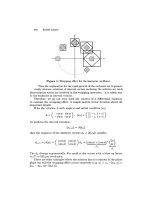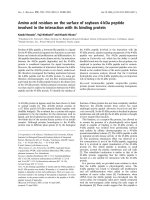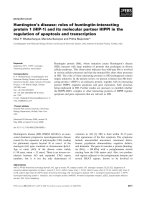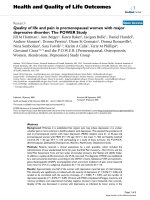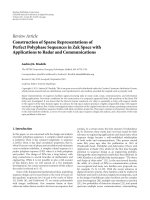Simulation of auto inhibition effect in mev ntail with its binding partner XD
Bạn đang xem bản rút gọn của tài liệu. Xem và tải ngay bản đầy đủ của tài liệu tại đây (4.17 MB, 100 trang )
SIMULATION OF AUTO-INHIBITION EFFECT
IN MEV NTAIL WITH ITS BINDING PARTNER XD
XIANG WEN WEI
(B.Sc.(Hons), ZJU)
A THESIS SUBMITTED FOR THE DEGREE OF
MASTER OF SCIENCE
DEPARTMENT OF BIOLOGICAL SCIENCES
NATIONAL UNIVERSITY OF SINGAPORE
2013
DECLARATION
ii
ACKNOWLEDGEMENTS
First of all, I would like to express my sincere gratitude to my supervisor,
Professor Christopher W.V. Hogue for his enormous patience, continuous support
and guidance all the way through those three years of my postgraduate study. You
have given me maximum flexibility and been enormously patient to allow me to
gradually pick up the project, training my autonomy and research independence. Your
encouragement, help and trust smooth the obstacles I encountered and make this insilicoproject a delightful exploration. Besides research, I also have learned both
presentation and communication skills. Thank you Chris, for being there, standing
nearby with inspiring advice and discussions.
Second, I am particularly grateful to Goi Chin Lui, Ariff Bin Abdul Aziz,
Muhammad Idris B Kachi Mydin, Nabila Binte Zahur, Tey Yun Lan and Hu Yongli
for their effort and help initializing this project. I learned a lot from you guys, many
thanks buddies.
Third, I am grateful to you, my labmates and colleges: Liu Chengcheng, Arun,
Yao Minxi, Suhas, Zhao Chen, Zhang Bo, Le Shimin, Yuan Xin and all the others
who give me unconditional help and cheer me up when I am down. I get nothing but
all of the joy and fun we have had over the years. Thank you so much for your
academic, emotional and moral support.
In addition, I would like to thank Prof. Wu Min and Prof. Adam Yuan for
your kind help being my pre-thesis defence committee and thesis examiners.
Furthermore, I would thank Department of Biological Sciences of NUS for
offering my research scholarship and providing the opportunity to explore the cutting
edge research in computational biology and Mechanobiology Institute for providing a
comfortable research environment.
iii
Last but not least, I would like to thank my grandparents, parents and family
for your unconditional trust, supports and encouragement. Without you, my
achievements would be meaningless.
iv
Dedicated to the memory of my beloved grandfather, Xiang Shoumei (1932 – 2013).
v
CONTENTS
DECLARATION ............................................................................................................. II
ACKNOWLEDGEMENTS ..............................................................................................III
CONTENTS................................................................................................................... VI
SUMMARY .................................................................................................................... IX
LIST OF TABLES ......................................................................................................... XI
LIST OF FIGURES ....................................................................................................... XII
LIST OF ABBREVIATIONS ........................................................................................ XIII
1. INTRODUCTION .......................................................................................................15
1.1 Intrinsically Disordered Proteins ...........................................................15
1.1.1 Experimental technologies characterizing IDPs ............................15
1.1.2 Computational methods characterizing IDPs ................................16
1.2 Trajectory Directed Ensemble Sampling...............................................17
1.3 Paramyxovirus Background..................................................................18
1.3.1 Measles virus ...............................................................................19
1.3.2 MeV nucleocapsid protein interacting with phosphoprotein ........... 19
1.4 Objectives ............................................................................................21
2. METHODS ................................................................................................................27
2.1 Ntail Ensemble Generation...................................................................28
2.2 Docking and Collision Checking ...........................................................30
2.3 Filtering Threshold Determination.........................................................31
2.4 Data Repository and Web Retrieval .....................................................32
3. RESULTS..................................................................................................................34
vi
4. DISCUSSIONS ..........................................................................................................48
4.1 Ensemble Properties of the Five Generated Classes ...........................48
4.2 Collisional Asymmetry of Ntail Binding with XD ....................................49
4.3 Comparing with NMR data ...................................................................52
4.4 Directions for Drug Design ...................................................................53
5. FUTURE DIRECTIONS .............................................................................................54
6. CONCLUSIONS ........................................................................................................55
BIBLIOGRAPHY ...........................................................................................................56
APPENDIX ....................................................................................................................59
SFig. 1 Allcoil Ntail α-MoRE region residue Ramachandran Plot before
filtering. ......................................................................................................59
SFig. 2 Allcoil Ntail α-MoRE region residue Ramachandran Plot after filtering.
...................................................................................................................60
SFig. 3 Small Ntailα-MoRE region residue Ramachandran Plot before
filtering. ......................................................................................................61
SFig. 4 SmallNtail α-MoRE region residue Ramachandran Plot after filtering.
...................................................................................................................62
SFig. 5 Medium Ntail α-MoRE region residue Ramachandran Plot before
filtering. ......................................................................................................63
SFig. 6 Medium Ntail α-MoRE region residue Ramachandran Plot after
filtering. ......................................................................................................64
SFig. 7 Large Ntail α-MoRE region residue Ramachandran Plot before
filtering. ......................................................................................................65
SFig. 8 Large Ntail α-MoRE region residue Ramachandran Plot after filtering.
...................................................................................................................66
A.
Read_Execute_me.txt........................................................................67
vii
B.
MeV_TraDES_Rama.txt.....................................................................68
C.
MeV_log_Rama_functions.txt ............................................................72
D.
MeV_R_analysis.txt ...........................................................................84
E.
MeV_alphaMore_picking_befdock.txt.................................................91
F.
MeV_alphaMore_picking_aftdock.txt .................................................95
G.
CGI script ...........................................................................................99
viii
SUMMARY
An in-silico simulation of large conformational ensembles of the intrinsically
disordered portion of Measles virus (MeV) nucleocapsid tail (Ntail) was used to
examine the conformational space and collisions involved in binding to the
polymerase P protein. One million protein 3D conformers of Ntail were generated
with populations of binding motif constrained to helix fractions derived from
published NMR experiments. A transient helix of Ntail exists, varying from 13%
Small helix (aa 491-499) to 25% Medium helix (aa 486-499) to 12% Large helix (aa
486-502). The remaining 50% of Ntail NMR structures are in random coil
conformations. Another 0.5 million structures were generated with predicted fractions
of secondary structure using the GOR method.
A new dock-by-superposition method was employed to produce complexes
of the Ntail structures with the crystallographic structure 1T6O. A dual threshold was
established involving the RMSD of the local helix motif and a count of total atomic
collisions to distinguish the plausible bound conformations from those that could not
bind. Results shows that 37.8% of the 1 million conformers mimicking the NMR
conditions survived the filtering, indicating the intrinsically disordered Ntail
contributes to discourage the binding of the virus nucleocapcid and catalytic
phosphoprotein, i.e. auto-inhibitory effect exists for Ntail interacting with other
proteins.
An asymmetric effect is seen where the flanking region at the C-terminus of
the helix is the more likely cause of entropic auto-inhibition due to the high number
of collisions, compared to the N-terminus flanking region. The longer the helix, the
larger Rgyr of the protein is, thus becoming more rigid. The degree of auto-inhibition
effect is Ntail helix length dependent. The α2 and α3 helix of XD domain of the P
protein and Ntail α-MoRE region Arg residues have severe rotamer collisions when
binding, in agreement of NMR chemical shift experiments. The GOR method
ix
ensembles show similar results and can be used to predict these properties of Ntail
without NMR data, with only 3-state secondary structure information. The study
sheds light on the structural basis of auto-inhibition, structural binding asymmetry
when Ntail interacts with XD and to the therapeutic drug design against MeV.
x
LIST OF TABLES
Table 1 Binding kinetics and free energy of MeV Ntail mutants and other
Mononegavirales member binding with their respective XD........................ 24
Table 2Right hand alpha helix conformational weight in α-MoRE region before
and after filtering for all classes. ..................................................................... 47
xi
LIST OF FIGURES
Fig. 1 Mononegavirales family members. ............................................................... 24
Fig. 2 Schematic representation of MeV N and P. ................................................. 25
Fig. 3 Ntail conformer structure representation of five classes trajectory
distribution files. ............................................................................................... 25
Fig. 4 Schematic representation of five classes of Ntail binding with XD (A-E)
and MeV ribonucleoprotein complex (F). ....................................................... 26
Fig. 5 Flow chart of simulation processes. ............................................................ 29
Fig. 6 Snapshot of the web server GUI. .................................................................. 33
Fig. 7 Density plot of RMSD for generated five classes........................................ 34
Fig. 8 RMSD mean value and deviations for each class. ...................................... 35
Fig. 9 Rgyr distribution of all classes before filtering. .......................................... 35
Fig. 10 Density plot of interchain crashes for three categories of manually
classified collision severity.............................................................................. 39
Fig. 11 Ensemble distribution of number of collisions against RMSD. .............. 40
Fig. 12 Per residue collision density of XD when binding to Ntail. ..................... 41
Fig. 13 Average number of interchain collisions for each Ntail residue before
filtering (upper panel A) and after filtering (down panel B). ......................... 43
Fig. 14 Percentage of conformers survived filtering. ............................................ 44
Fig. 15 Gor α-MoRE region residue Ramachandran Plot before filtering. .......... 45
Fig. 16 Gor α-MoRE region residue Ramachandran Plot after filtering. .............. 46
xii
LIST OF ABBREVIATIONS
aa: Amino acid
AFM: Atomic force microscopy
CD: Circular dichroism spectroscopy
EPR: Electron Paramagnetic Resonance
F: Fusion protein
FRET: Fluorescence resonance energy transfer
G: Attachment glycoprotein does not bind sialic acid
H: Attachment protein use cellular surface sialic acid as their receptors
HeV: Hendra virus
IDPs/IDRs: Intrinsically disordered proteins/regions
ITC: Isothermal titration calorimetry
L: Large catalytic subunitof RNA polymerase complex
M: Matrix protein
MD: Molecular dynamics
MeV: Measles virus
MuV: Mumps virus
N: Nucleoprotein
Ncore: N terminal domain of nucleoprotein
NDV: Newcastle disease virus
NiV: Nipah virus
NMR: Nuclear magnetic resonance spectroscopy
NPCs: Nuclear pore complexes
Ntail: C terminal domain of nucleoprotein tail
Nucleocapsid: N-RNA complex
Nups: nucleoporins
P: Phosphoprotein
xiii
PCT: Phosphoprotein C terminal domain
PDB: Brookhaven Protein Data Bank
PMD: Phosphoprotein multimerization domain
PNT: Phosphoprotein N terminal domain
PRE: Paramagnetic relaxation enhancement
RDCs: Residue dipolar couplings
Rgyr: Radius of gyration
RMSD: Root mean squaredeviation
SAXS: Small angle X-ray scattering
SVD: Singular Value Decomposition method
TraDES: Trajectory directed ensemble sampling
XD: C terminal X domain of phosphoprotein
α-MoRE: Alpha-helical molecular recognition element
xiv
1. INTRODUCTION
1.1 Intrinsically Disordered Proteins
The traditional paradigm of well-defined protein tertiary structures encoding
biological function has been challengedby a multitude of disordered or partially
structured regions that are both functional and conserved[1,2]. Intrinsically disordered
proteins/regions (IDPs/IDRs), with a relative flat energy landscapes, lack a unique,
well defined stable structure under physiological conditions. Thus they are better
represented as an ensemble of rapidly interconverting structures. By analogy to
denatured states of globular proteins, the conformational behavior and structural
features of IDPensemblesare represented between the ordered and coil disorder states,
i.e. molten globule like (collapsed disorder) or pre-molten globule like (extended
disorder) forms[3].IDPs arehighly abundant in nature, composing more than 30% of
eukaryotic proteins, and this fraction seems to be enriched with increasing organism
complexity [4]. IDPs are more resistant to both heat and cold stress compared to
globular proteins[5]. Disordered regions can often bind to multiple partners (one to
manybinding mode) and vice versa (many to onebinding mode)[6]. In protein
interaction networks, hub proteins are found to contain higher proportions of
disordered regions, enabling binding diversity.These disordered regions participate in
various cellular regulations: transcription regulation, signal transduction, and
molecular recognition etc.[7]. They are potential abundantly new drug targets
involving in various human diseases likeneurodegenerative disorders diseases,
diabetes, cardiovascular disease, and others [2,8].
1.1.1 Experimental technologies characterizing IDPs
The intrinsic structural heterogeneity of IDPs results in incoherent X-ray
scattering, withmissing or poorly defined electron density from X-ray crystallography
15
study. IDPsalso perturb the formation of protein crystals and it would be only one
single conformer from a repertoire of all possible conformation ensemblesfor a
crystals and structure to be obtained. Thus X-ray crystallography is unable to address
IDPs
ensemble
conformations.
properties
The
involving
widespread
dynamic
prevalence,
motion
and
heterogeneous
biological
and
pharmaceutical
importance of IDPs spurs the development of new techniques to address the
understanding of this system. Nuclear magnetic resonance (NMR) dominates in
characterizing IDPs’ conformation ensemble with measurements of chemical shifts
reporting protein secondary structure, residue dipolar couplings (RDCs) revealing the
angle of a bond relative to an external frame of reference, and paramagnetic
relaxation enhancement (PRE) on long range structural restraints[9,10] as the most
important NMR methods. Other biochemical/biophysical techniques, small angle Xray scattering (SAXS), spectroscopic methods like circular dichroism (CD), single
molecule techniques like fluorescence resonance energy transfer (FRET), atomic
force microscopy (AFM), Raman optical activity, and protease sensitivity can be
combined with NMR data to further understandthe ensemble forms taken up by IDPs
within their allowedconformation space[3,11,12].
1.1.2 Computational methods characterizing IDPs
IDPs differ from structured proteins in several ways, including flexibility,
sequencecomposition, hydrophobicity, charge, sequence complexity, type and rate of
residue evolutionary substitutions. For example, the sequential composition of IDPs
are biased and often enriched with polar and charged amino acids P, Q, S, E, G, K, D,
R and A (disorder promoting amino acids) while containing a lesser content of
hydrophobic amino acids T, N, M, H, V, F, L, Y, W, C and I (order promoting amino
acids) which usually are responsible for forming the hydrophobic core of ordered
proteins [13,14]. Such common features are utilized by more than 50 IDP predictors
16
to discriminate between ordered and disordered proteins, applicable for
genome/proteomewide analysis [15,16].
While many such methods exist to predict sequence that forms IDPs, there is
a much smaller set of methods that can be used to understand the conformational
ensembles, i.e. the representative structures of IDP, and do so without additional
information from NMR or SAXS measurements. IDPs,with extremely high degrees
of freedom, can not be fully characterized as most experimental measurements can
only report ensemble averaged structural properties [17]. This inherently
undetermined problem is complemented with computational methods and
computational techniques constructing conformational ensembles consistent with
experimental data are recently reviewed [18-20].
1.2 Trajectory Directed Ensemble Sampling
Trajectory Directed Ensemble Sampling (TraDES) is software developed by
Feldman and Hogue earlier in the Hogue laboratory which samples protein structures
in available conformational space. TraDES is a fast C program set that can generate
reasonably sized ensembles of 3D structures of an IDP sequence. It works by
sampling protein conformational space via probabilistic sampling, building up
random protein conformations one amino acid at a time. It chooses amino acid
backbone and rotamer angles from predefined conformational libraries obtained from
a non-redundant set of proteins from Brookhaven Protein Data Bank (PDB) [21,22].
The generated initial ensembles containing numbers as large as millions of
conformations can be filtered with environment or structure based restrains (binding
partners or spatial excluded volume constrains formed by proteins/domains nearby),
mimicking protein dynamics. TraDES requires much less computational resources
and time than energy potential based molecular dynamics simulations, and yet
provides high quality all-atom coordinate data.
17
1.3 Paramyxovirus Background
Viruses within the Mononegaviralesorder contain members of linear, nonsegmented, single-stranded, negative-sense RNA virus. The RNA genome is
encapsulated by nucleoprotein (N) forming a helical nucleocapsid. Mononegavirales
has four families: Bornaviridae, Filoviridae, Paramyxoviridae and Rhabdoviridae
(Fig. 1). This order is expanding considerably in those years and the Paramyxovirinae
subfamily is well established under Paramyxoviridae family. Paramyxovirusspecies
have a globally significant impact in both economic cost and mortality, containing
well known highly infectious human pathogens, like Measles virus (MeV) and
Mumps (MuV), and fatal zoonotic virus, like the poultry infection Newcastle disease
virus (NDV), horse infecting Hendra virus (HeV), pig infecting Nipah virus (NiV),
and mouse infecting Sendai virus (SeV). They share common features as their linear
RNA genome encodes successively six proteins from 3’ to 5’: nucleoprotein (N),
phosphoprotein (P), matrix protein (M), fusion protein (F), attachment proteins (H or
G, depending if it uses cellular surface sialic acid as their receptors or not) and
polymerase large catalytic subunit (L).
Nucleoprotein N plays several roles besides wrapping the viral RNA with six
nucleotides per monomer forming a helical nucleocapsid [23]. Cellular RNA free
nascent N (N°) binds P as its chaperone to stay soluble in cytoplasm and to prevent
illegitimate self-assembly of N and illegitimate encapsulation of RNA [24]. N°-P
serves as substrate for nascent genomic RNA encapsulation, and these proteins are
schematically depicted in Fig. 2. The modular organization of P is conserved in all
Paramyxovirinae [25]. P usually exists as a multimer and tethers polymerase L to the
nucleocapsid template during transcription and replication. The N-RNA complex
(nucleocapsids) structure is resolved for Rabies virus (RAV) and respiratory syncytial
virus (RSV) which shows N binding the phosphate sugar backbone of the virus RNA
exposing the nucleotide bases to be read by L-P polymerase in transcription and
18
replication [26,27]. M, F and H/G orchestrates viral entry to and budding from host
cells during the viral life cycle [28].
1.3.1 Measles virus
MeV belongs to the Morbillivirus genus within Paramyxovirinae subfamily
of Paramyxoviridaefamily under Mononegaviralesorder (Fig. 1). It is responsible for
an acute contagious disease in human beings, bringing about symptoms ranging from
relatively mild diarrhea to potentially fatal lung and brain complications [29]. Even
though vaccination has efficiently prevented the occurrence of this disease, periodic
outbreaks and possible endemics require efficient treatment capable of eliminating
the virus directly. Thus, anti-viral drug development is a sustaining interest, both
commercially and socially.
Non-segmented, negative-sense, single-stranded MeV RNA genome is
encapsulated by N, forming as herringbone nucleocapsid acting as a template both for
transcription and replication. The RNA polymerase complex is composed of L and P
as shown in Fig. 4F. P is a modular protein, consisting an N terminal disordered
domain (PNT, P1-230) and a C terminal domain (PCT, P231-507), tethering the L protein
to the nucleocapsid template through multimerization domain of P (PMD, P304-375, Fig.
2 B). This ribonucleoprotein complex made of RNA, N, P, and L forms the basic
replicative unit. The L-P complex cartwheels along the spiral nucleocapsid template,
enabling replication along the entire length of MeV RNA genome [30] (Fig. 4F).
1.3.2 MeV nucleocapsid protein interacting with phosphoprotein
The nucleocapsid N protein consists of two parts: a structured N terminal
domain (Ncore, N1-400) and a C terminal moiety (Ntail, N401-525) as shown in Fig. 2. A.
N°monomer may undergo self-assembling and self-encapsidating genome RNA. The
domain regions required for N-N self-assembly and RNA binding is located in Ncore.
19
And a functional nuclear localization sequence (NLS) is also located in Ncore (N70-77)
[31]. Ntail, enriched in disorder promoting residues (R, Q, S, E) is both
computationally predicted and experimently verified to be intrinsically disordered and
conserved among Morbillivirus members (Fig. 2A) [25,32]. A nuclear export
sequence (NES) is located in Ntail (N425-440) [31]. An alpha-helical molecular
recognition element (α-MoRE) forms a transient α helix involved in protein binding,
and the helical signal is both predicted and verified within the Box2 region (N486-502)
[33,34]. α-MoRE binds to a long hydrophobic cleft created by the α2 (P476-490) and α3
(P492-506) helix from the antiparallel triple helix bundle C terminal X domain (XD,
P459-507) of P, forming a stable four helix bundle which can be crystallized. Previous
NMR studies shows unbound α-MoRE is preconfigured in a helical form without the
presence of XD and the helix length and population varies from 13% small (N491-499),
25% medium helix (N486-499) and 12% large (N486-502) with the remaining 50% coil
conformations [35]. Ntail also interacts with cellular proteins like heat shock protein
hsp72 which enhances polymerase processivity and its NES interacts with cellular
proteins responsible for nuclear export of N [36]. Nucleoprotein Box 1 binds to an
uncharacterized nucleoprotein receptor (NR), expressed at the surface of lymphoid
origin dendritic cells leading to cell cycle arrest while Ncore interacts with FcγRII
triggering apoptosis [37]. The function of Box 3 in Ntail XD interaction is
controversial. Some claim Box 3 establishes weak non-specific contacts with XD and
inhibits viral transcription and replication while others think it does not involve in the
Ntail XD binding process [24,32,38].
Among Mononegavirales, MeV Ntail and XD is mostly characterized by
deletion analysis, CD and surface plasma resonance analysis, protease digestion,
SAXS analysis, X-ray and NMR structures, isothermal titration calorimetry (ITC)
binding analysis, and electron paramagnetic resonance analysis [32,34-36,38-41].
Within Mononegavirales, the N, P, and L proteins of MeV and SeV are functionally
equivalent, but the sequence identity is limited. SeV Ntail span from aa 402-524
20
almost identical to the length of MeV [42]. The XD domain of P adopts the same
antiparallel triple helix bundle arrangement. Thus the mechanisms of transcription
and replication of MeV and SeV are quite similar. However, contrasting to MeV’s
hydrophobic interaction between Ntail and XD, SeV is dominated by electrostatic
forces whereas positively charged Ntail α-MoRE (four Ntail arginine side chains
R482, R486, R490, and R491) binds to negatively charged patch formed by α2 and
α3.
The binding affinity of KD between XD and Ntail in these and other members
in Mononegavirales differs significantly (Table 1), ranging from nM to μM. The
rabies virus RAV has affinity similar to the wild type MeV Ntail and XD interaction.
However in RAV, the C-terminal N-RNA binding domain of P contain six α-helices
and a two-stranded antiparallel β sheet, which differs with MeV’s three α-helix
structure [43]. The RAV’s P-L on and off nucleocapsid cycling is proposed to
proceed differently with MeV’s cartwheeling mechanism, in that the many RAV P
proteins may bind permanently to the nucleocapsid template with L catalytic unit
jumping between adjacent P proteins [44,45]. The study of HeV and NiV are
analogous to the study of MeV [46,47]. The other virus members are much less
characterized and relevant functional, structural information of Ntail interacting with
P is quite limited.
1.4 Objectives
Auto-inhibition usually refers to a molecule inactivates itself by a
conformation binding to itself through an internal domain producing a non-binding
structure. The study of cytoplasmic disordered nucleoporins (Nups) in nuclear pore
complexes (NPCs) indicate that auto-inhibition functions as a meshwork shield
excluding nonspecific transportation for macromolecule selective exchange [48].
Considering the dynamic properties of Ntail protruding from the surface of
21
nucleocapsid (Fig. 4F), it is possible that, like nucleoporins, they posses an autoinhibition mechanism to selectively bind to its favored targets while rejecting
nonspecific binding to the pre-formed α-MoRE helix region.
As previous research focused mainly on the function and structural transition
of Box 2 and Box 3 concerning the interaction of Ntail binding with XD, the
functional role of C terminal region of Ntail linking the Box 2 and Box 3 is largely
neglected. In this study the Ntail region is examined by TraDES structure sampling
and docking to the XD structure to determine whether any auto-inhibition effect can
be observed within conformational ensembles including variable length α-MoRE
helices. In addition, the functional role of the sequence region separating the α-MoRE
helix containing Box 2 and the C-terminal Box3 is examined. A large ensemble of
Ntail conformations consisting of 1 million plausible three dimensional structures is
constructed with the TraDES package version 20110318 with the α-MoRE helix
population in small, medium, large and coil forms set in accordance with NMR data
(Fig. 4A-D), with population size representing its frequency in NMR ensemble
observations [35]. These TraDES generated protein structures are then each
superimposed with chain B of a chimera crystal structure (PDB code: 1T6O)
containing XD aa 457-507 (chain A) and α-MoRE aa 486-505 (chain B) and filtered
with steric collision parameters to reject those structures that can not bind, leaving a
plausible bound sub-ensemble. Steric parameters for filtering include both root mean
square deviation (RMSD) from chain B from 1T6O and number of steric atomic
collisions when binding to XD. The filtered sub-ensemble considered plausible bound
conformers. Another 0.5 million structure ensemble of Ntail conformations is created
with GOR three state secondary structure prediction which constrains conformational
space according to secondary structure (Gor class, Fig 3E). This set of structures is
filtered with the same filtering threshold obtained from the NMR data based 1 million
structure ensemble. The GOR sampling represents a blind study of the types of
structures that the TraDES software could make with variable fractions of α-MoRE
22
helix but without prior knowledge of the fractions of α-MoRE helix already
characterized by NMR. The Gor data set is used to determine whether simple
secondary structure based conformational sampling bias can provide a similar result
as that biased by known fractions of and α-MoRE from NMR measurements. The
results shed light on the structural basis of binding, the conformational space of the
Box 3 and α-MoRE region in bound and free states, auto-inhibition effects of regions
flanking Box 2, and to the therapeutic drug design against MeV.
23
Fig. 1 Mononegavirales family members.
Region of N studied at 20°C,
MeV Ntail (401-525)
MeV Ntail∆3
MeV Ntail∆3 Flag
MeV Ntail482-525
MeV Box2 peptide(N487-507)
HeV Ntail (400-532), 0.2M NaCl
NiV Ntail (400-532), 0.2M NaCl
SeV Ntail (402-524) 0.5M NaCl
RABV Ntail
KD
170 ± 20 nM
330 ± 50 nM
186 ± 25 nM
389 ± 24 nM
20 nM
8.7 ± 0.55 μM
2.1 ± 0.24μM
57 ± 18 μM
160 ± 20 nM
Binding
enthalpy,
∆H(kJ mol-¹)
56.64 ± 0.686
44.50 ± 1.013
52.40 ± 0.644
40.00 ± 0.523
23.36 ± 0.259
37.80 ± 0.456
Binding entropy
∆S(J mol-¹ deg-¹)
-60.3
-25.1
-46.9
-13.8
-17.1
-20.3
entropy
contribution %,
|T*∆S*100%/∆H|
2.13
1.13
1.79
0.69
1.46
1.07
Ref
[38]
[38]
[38]
[38]
[36]
[47]
[47]
[42]
[49]
Table 1 Binding kinetics and free energy of MeV Ntail mutants and other Mononegavirales member binding with their respective XD.
For MeV Ntail binding with its XD, the full length form N401-525, a form without Box3 (Ntail∆3), a form which the native Box 3 region is replaced by a flag
sequence DYKDDDDK (Ntail∆3Flag), a form composing residues N482–525 and a form encompassing only the Box 2 region N487-507peptide
(DSRRSADALLRLQAMAGISEE). The other forms used are wild type Ntail. MeV: Measle virus; RABV: Rabies virus; SeV: Sendai virus; HeV: Hendra
virus; NiV: Nipah virus.
24
Fig. 2 Schematic representation of MeV N and P.
A) Structured and unstructured regions of N protein. The three Ntail boxes are
conserved among Morbillivirus members (grey box) with Box 2 and Box 3 involving in
interaction with XD, regulating virus transcription and replication. The α-MoRE
sequence within Paramyxovirus family with similarity greater than 60% are greyed out
and identical residues are underscored [24]. There is a functional nuclear localization
sequence (NLS) in Ncore and nuclear export sequence (NES) in Ntail [31]. B)
Modular organization of P protein. Three anti-parallel α-helix regions form a triple
helix bundle with a hydrophobic cleft delimited by α2 and α3.
Fig. 3 Ntail structures representing helical region samples from the five classes
of trajectory distribution files.
The one letter code of amino acid representation together with its sequence location
is used to illustrate the α-MoRE sub-region where the dihedral angles of their
trajectory files are fixed as obtained from crystal structure 1T6O.The torsion angles
for Helix class (Small, Medium, Large) are correspondingly fixed in Ntail91-99, Ntail86-99
and Ntail86-102 and their other entire Ntail region is set as “allcoil” secondary structure
type. The length and location of helix represents this difference. The Allcoil class
whole Ntail region is fixed to “allcoil” secondary structure type in TraDES package.
The Gor class uses predicated secondary structure with GOR functions for the entire
Ntail region, but the helical angles are not rigidly fixed, hence the GOR sampled
structures may have bent or distorted helices in the α-MoRE region.
25
